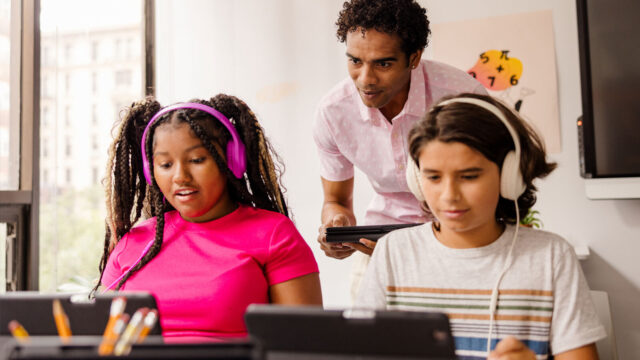
Gaming is wildly popular. More than 2 out of every 3 Americans play video games, and that doesn't even take into account all the nondigital types of gaming, such as card games, board games, or children's games like tag or hide-and-seek. Even little acts like “I’m going to flip a coin to determine which movie to watch” can count as a game and illustrate that there is something about a game that is universally appealing.
Games are known to offer quite a few benefits, too. Teachers have used the Civilization game series to teach history. Walden, a game completely immerses players into a work of literature. Good games teach players new ways of seeing and understanding problems, and if you want to teach kids the value of sheer persistence, stick them in front of a vintage video game console for a while.
Using Games in Education
Educators have taken note. Whether it’s as small as finding a game for a few students to play or as large as asking all students in a state to come together and create games, it is no secret that games are a powerful way to motivate and facilitate learning.
When it comes to games in education, there are two overall forms it can take:
- Games designed for entertainment being used in an educational setting
- Educators adopting features of game design to enhance learning
It is important to acknowledge the first form. There is an abundance of overlap between playing a game and learning a concept. Consider, for example, the persistence required to beat a video game level or the instant feedback that comes with being unsuccessful. See the academic work of Dr. James Paul Gee for an in-depth analysis of the relationships between gaming and learning.
Even genres of games that adults frequently dismiss, like fast-paced action video games or match-three puzzle mobile games, are shown to have educational benefits. In the education world, rote skill-and-drill games are sometimes criticized on focusing on the wrong part of learning, but they often still employ characteristics such as rewards, goals, and narrative, which can produce demonstrative gains in learning.
What Is Gamification in Education?
When educators talk about gamification, they are generally referring to the second form listed above. Gamification in education means that educators apply game design elements to an educational setting. The goal is usually to make learning more engaging.
Breaking the concept of a “game” down into constituent game design elements is tricky, considering how vast the differences are among, say, chess, The Sims, and tag. There is in fact a range of elements that games might have, with different players being attracted to different elements. Researcher Dr. Nick Yee proposed one way to model the elements of what motivates gamers:
- Action (e.g., objectives)
- Social (e.g., competition)
- Mastery (e.g., scoring)
- Achievement (e.g., awards)
- Immersion (e.g., roleplaying)
- Creativity (e.g., customization)
When educators adopt features like the ones listed into a lesson, even if the result isn’t quite a game, the lesson has been gamified. Some features are commonly tried, such as scoring and badges, but educators should also be mindful of less-structured features like decorating a classroom to match a lesson's setting or tasking students with unusual projects. Imagine students not wanting to leave their circle of education!
When implemented well, a gamified lesson keeps learning objectives the same but makes the learning process more fun. Gamification is a tool that can build motivation and interest, in effect reducing student-driven issues in the teaching process.

Gamification in Education Examples
Whether you are interested in games in education or the gamification of education, there are examples that span everything from early childhood learning to undergraduate-level concepts.
We think about it in our own products at HMH and use the principles of gaming to ensure that learning is fun. In Waggle, students receive in-program rewards and are delivered lessons that stay in their zone of proximal development, similar to how when playing a video game, each level is designed to be just slightly more challenging than the previous one.
Math 180 awards achievements to students, including for achievements rooted in displaying a growth mindset, such as persisting after failure. It also includes real-world simulations and math-focused video games, along with a game show-like practice board that lets students choose which questions to answer first and see their points accumulate. In fact, video games can be found in Waggle, too, along with our math programs Into Math and Math Expressions.
While we pride ourselves in the games we have built, we are far from the only organization to consider ways that games can promote learning! In 2011, MinecraftEdu was released, an educational version of Minecraft where freeform building is connected to lessons in everything from architecture to ratios. Or there’s the Oregon Game Project Challenge, an annual statewide competition where middle school and high school students work to design games together based on that year's theme. Designing games is in itself a high-value endeavor with learning opportunities in computer science, graphic design, and storytelling (to name a few).
Gamification of Learning
There isn’t a one-size-fits-all approach to gamifying learning. If you're trying to make your next lesson more fun, consider what games and game features are best suited for your unique situation. Do your students thrive on competition? What about collaboration? Here are some ideas to up your classroom engagement factor:
- Create classroom avatars: If many of your students play games that let the player create characters, you could have your students create alter-egos that they can personalize and build upon. They can “unlock” clothes and modifications by completing class tasks or develop different skill sets such as “engineer” or “historian” that you can turn into custom projects.
- Award badges: This can range from handing out simple printed badges after completing an assignment to having yearlong online leaderboards. When deciding what sorts of badges to award students, be sure to think about all of your students. Focus on rewarding healthy learning habits, such as staying focused or persisting through failure, instead of simply rewarding good grades.
- Turn learning into class quests. Give students agency and motivation by turning learning objectives into quests! These can be solo quests (e.g., “Speak to the music teacher and collect three facts about Italian music”) or class-wide quests (e.g., “Read 100 books”). You can give students options for which quests to go on to not only differentiate learning but also offer them more control over their learning. You could even create a class-wide quest board that encourages collaboration.
- Connect classic games to school subjects. Certainly plenty of teachers have turned chapter reviews into quiz game shows. But you can work with any games you have access to. Consider modifying a property-acquisition game you like so that the properties are historical landmarks. Or have students play a word game but reward certain categories of vocabulary words.
Ultimately the only limit is your imagination. What games do you play? What about your students? Think critically about what makes them fun and be on the lookout for ways to make learning fun, too!
* * *
Explore Waggle, our K–8 practice app for math and ELA. It was designed using principles of gaming to ensure that learning is fun.
Discover best practices for integrating AI in the classroom.












